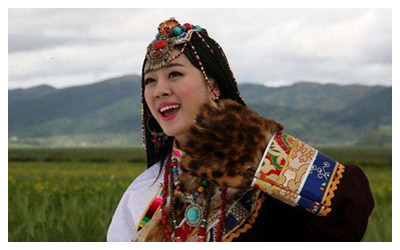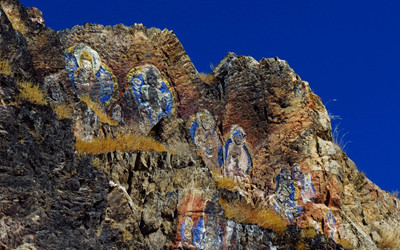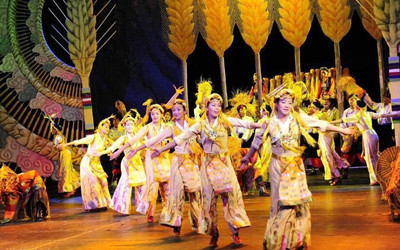
Tibetan ,also Zang ethnic minority, with a population of 5,416,021 mostly live in the
Tibet Autonomous Region. There are also Tibetan communities in Qinghai, Gansu, Sichuan and Yunnan provinces.
Langauge
Tibetan language belongs to the Tibetan sub-branch of the Tibetan-Myanmese language branch of the Chinese-Tibetan language family. According to geographical divisions, it has three major local dialects: Weizang, Kang and Amdo. The Tibetan script, an alphabetic system of writing, was created in the early 7th century. With four vowels and 30 consonants, it is used in all areas inhabited by Tibetans.
Religion
Tibetan Buddhist, They believe in the Indian Mahayana form of Buddhism but have gradually developed a distinctive Tibetan Buddhism which is also called Lamaism.
History of Tibetan
The Tibetans first settled along the middle reaches of the Yarlung Zangbo River in Tibet. Evidence of the new and old stone age culture was found in archaeological excavations at Nyalam, Nagqu, Nyingchi and Qamdo.

According to ancient historical documents, members of the earliest clans formed tribes known as "Bos" in the Shannan area. In the 6th century, the chief of the Yarlung tribe in the area became leader of the local tribal alliance and declared himself the "Zambo" (king). This marked the beginning of Tibetan slavery society and its direct contacts with the Han people and other ethnic groups and tribes in northwest China.
At the beginning of the 7th century, King Songzan Gambo began to rule the whole of Tibet and made "Losha" (today's Lhasa) the capital. He designated official posts, defined military and administrative areas, created the Tibetan script, formulated laws and unified weights and measures, thus establishing the slavery kingdom known as "Bo," which was called "Tubo" in Chinese historical documents.
After the Tubo regime was established, the Tibetans increased their political, economic and cultural exchanges with the Han and other ethnic groups in China. The Kingdom of Tibet began to have frequent contacts with the Tang Dynasty (618-907) and the Tibetan and Han peoples got on well with each other. In 641, King Songzan Gambo married Princess Wen Cheng of the Tang Dynasty. In 710, King Chide Zuzain married another Tang princess, Jin Cheng. The two princesses brought with them the culture and advanced production techniques of Central China to Tibet. From that time on, emissaries traveled frequently between the Tang Dynasty and Tibet. The Tibetans sent students to Changan, capital of the Tang Dynasty, and invited Tang scholars and craftsmen to Tibet. These exchanges helped promote relations between the Tibetans and other ethnic groupss in China and stimulated social development in Tibet.
From the 10th to 12th century, Tibet fell apart into several independent regimes and began to move towards serfdom. It was at this time that Buddhism was adapted to local circumstances by assimilating certain aspects of the indigenous religion, won increasing numbers of followers and gradually turned into Lamaism. Consisting of many different sects and spread across the land, Lamaism penetrated into all spheres of Tibetan life. The upper strata of the clergy often collaborated with the rich and powerful, giving rise to a feudal hierarchy combining religious and political power and controlled by the rising local forces.

The Yuan Dynasty (1279-1368) founded by the
Mongols in the 13th century brought the divided Tibet under the unified rule of the central government. It set up an institution called Xuanzhengyuan (or political council) and put it in charge of the nation's Buddhist affairs and Tibet's military, governmental and religious affairs.
Phagsba, a Tibetan lama, was given the title of imperial tutor and appointed head of the council. The Yuan court also set up three government offices to govern the Tibetan areas in northwest and southwest China and Tibet itself. The central government set up 13 Wanhu offices (each governing 10,000 households) in Inner and Outer Tibet east of Ngari. It also sent officials to administer civil and military affairs, conduct census, set up courier stations and collect taxes and levies. Certificates for the ownership of manors were issued to the serf owners and documents given to local officials to define their authority. This marked the beginning of the central authorities' overall control of Tibet by appointing officials and instituting the administrative system there.
The ensuing Ming Dynasty (1368-1644) carried over the Tusi (headmen) system in the Tibetan areas in northwest and southwest China. In Tibet proper, three sect leaders and five secular princes were named. These measures ensured peace and stability in the Tibetan areas during the Yuan and Ming dynasties, and the feudal economy there developed and culture and art flourished. Tibet's contacts with other parts of the country became more frequent and extensive.
The Qing Dynasty (1644-1911), the last monarchy in China, set up a government department called Lifanyuan to administer affairs in Tibet and
Mongolia. In Tibet, the Qing emperor conferred the titles of the "Dalai Lama" (1653) and "Bainqen Erdini" (1713) on two living Buddhas of the Gelugba sect of Lamaism. The Qing court began to appoint a high resident commissioner to help with local administration in 1728, and set up the Kasha as the local government in 1751. In 1793, the Qing army drove the Gurkhas invaders out of Tibet and formulated regulations concerning its administration.
The regulations specified the civil and military official appointment systems and institutions governing justice, border defense, finance, census, corvee service and foreign affairs, establishing the high commissioners' terms of reference in supervising
Tibetan affairs.
In other areas inhabited by
Tibetans in northwest and southwest China, the
Qing court continued the Tusi (headmen) system established by the Yuan and Ming dynasties, and put them under the administration of the Xining Commissioner's office (established in 1725) and the Sichuan governor (later the Sichuan-Yunnan border affairs minister).
After the Republic of China was founded in 1911, the central government set up a special department to administer Mongolian and Tibetan affairs. In 1929, the Kuomintang government set up a commission for Mongolian and Tibetan affairs in Nanjing and established
Qinghai Province. In 1939, Xikang Province was set up. The Tibetan areas in northwest and southwest China, except Tibet, were placed under the administration of
Qinghai, Gansu, Sichuan, Xikang and Yunnan provinces respectively
After the Chinese Communist Party was founded in 1921, its central committee clearly stated in its Agrarian Revolution Program that the feudal privileges of Tibetan princes and Lamas would be abolished. During its Long March northward to fight the Japanese invaders, the Chinese Worker and Peasant Red Army passed through Tibetan areas in Sichuan, Xikang, Yunnan, Gansu and
Qinghai, where they mobilized the poor Tibetans to carry out land reform and establish democratic political power of the laboring people. Areas inhabited by Tibetans were liberated one after another after the founding of the People's Republic of
China in 1949.
Tibet proper was liberated peacefully in 1951.
Life Style of Tibetan
Food & Dining
Usually the Zang people eat three meals a day, but during the busy harvest season they will have four, five and often more. Their staple foods are tsamba, yak butter tea, mutton, and beef. Tsamba, made of highland wheat (Qingke) is convenient to carry around and eat whenever you want, so you can see many of them carrying tsamba bags. As for drinks, they enjoy chang, a type of wine also made from Qingke, and milk tea. The Tibetan knife, sharp and delicate, is often used to cut meat.
Clothes & Dressing
In general the Zang men wear plaits on the head and women wear them on the shoulders. They all wear gowns with long sleeves. When they are dancing, their sleeves look wings flapping in the air. The monks wear cassocks whose colors vary according to their particular sect of Tibetan Buddhism.
Customs & Culture
Living on the world famous plateau, they also boast a unique lifestyle and set of skills. In the field of the arts, Tibetan calligraphy values strictness and delicateness, be it on steles or sutras; The Thangka and other Buddhist pictures, with fluent lines and bright colors, depict figures vividly; their architecture, like the
Potala Place and
Jokhang Temple, is charming and brilliant; the Zang people are famous for expressing their feelings through song and dance, notably the step dance and the masked Tibetan opera. Princess Wencheng is one of the eight best known plays.In the scientific arena, Tibetan medicine, combining various forms of traditional Chinese medicine, is said to have developed the schools of acupuncture and massage. The
Mentsekhang (Tibetan Traditional Hospital) is its home. The Tibetan calendar is also worthy of mention, for it is complete and has helped the Zang people a lot.
Festivals of Tibetan
 The most important festival in the calendar is the first day of the Tibetan New Year. They clean their rooms in preparation for that day, paint symbols of auspice, and warmly greet each other in the morning. On the fifteenth day, they attend the Butter Lamp Festival.
The most important festival in the calendar is the first day of the Tibetan New Year. They clean their rooms in preparation for that day, paint symbols of auspice, and warmly greet each other in the morning. On the fifteenth day, they attend the Butter Lamp Festival.
Another festival, the Saka Dawa Festival falls on the fifteenth day of the fourth month, and celebrates the birth of Sakyamuni and the arrival of Princess Wencheng. This festival involves a wide range of activities. On the Shoton Festival, the first day of the seventh Tibetan month, they take pots and wares to enjoy tea, yogurt and yak butter tea in a scenic place.
The Great Prayer Festival and The Bathing Festival are also important festivals. If you are a guest in Tibet, the Zang people may give you a gift of a 'hada', a kind of white ribbon. This represents their warmest heart.

 Tibetan ,also Zang ethnic minority, with a population of 5,416,021 mostly live in the Tibet Autonomous Region. There are also Tibetan communities in Qinghai, Gansu, Sichuan and Yunnan provinces.
Tibetan ,also Zang ethnic minority, with a population of 5,416,021 mostly live in the Tibet Autonomous Region. There are also Tibetan communities in Qinghai, Gansu, Sichuan and Yunnan provinces. According to ancient historical documents, members of the earliest clans formed tribes known as "Bos" in the Shannan area. In the 6th century, the chief of the Yarlung tribe in the area became leader of the local tribal alliance and declared himself the "Zambo" (king). This marked the beginning of Tibetan slavery society and its direct contacts with the Han people and other ethnic groups and tribes in northwest China.
According to ancient historical documents, members of the earliest clans formed tribes known as "Bos" in the Shannan area. In the 6th century, the chief of the Yarlung tribe in the area became leader of the local tribal alliance and declared himself the "Zambo" (king). This marked the beginning of Tibetan slavery society and its direct contacts with the Han people and other ethnic groups and tribes in northwest China. The Yuan Dynasty (1279-1368) founded by the Mongols in the 13th century brought the divided Tibet under the unified rule of the central government. It set up an institution called Xuanzhengyuan (or political council) and put it in charge of the nation's Buddhist affairs and Tibet's military, governmental and religious affairs.
The Yuan Dynasty (1279-1368) founded by the Mongols in the 13th century brought the divided Tibet under the unified rule of the central government. It set up an institution called Xuanzhengyuan (or political council) and put it in charge of the nation's Buddhist affairs and Tibet's military, governmental and religious affairs. The most important festival in the calendar is the first day of the Tibetan New Year. They clean their rooms in preparation for that day, paint symbols of auspice, and warmly greet each other in the morning. On the fifteenth day, they attend the Butter Lamp Festival.
The most important festival in the calendar is the first day of the Tibetan New Year. They clean their rooms in preparation for that day, paint symbols of auspice, and warmly greet each other in the morning. On the fifteenth day, they attend the Butter Lamp Festival. Ask Questions ?
Ask Questions ?